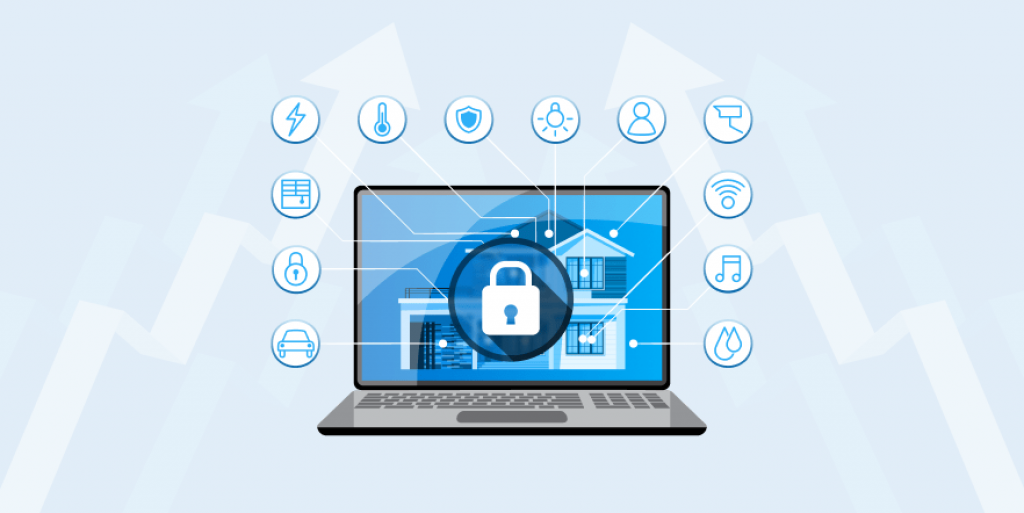Table of Contents
The rise of Internet of Things (IoT) devices has brought many benefits to different sectors, from smart homes and wearables to healthcare equipment. However, this increase in connectivity requires robust security measures to protect these devices and the data they collect. An essential component of IoT security is the IoT firewall, which plays an important role in shielding interconnected devices from potential cyber threats.
In this article, we will answer the “what is firewall in IoT?” question and will look at the way a robust firewall works, its key features, and how it contributes to the overall security of an IoT ecosystem.

What is a firewall in IoT?
An IoT firewall is a security tool made to protect communication and data transfer between IoT devices and the broader network. Its main job is to watch and control the traffic going to and from these devices, reducing the risk of unauthorized access, data breaches, DDoS attacks, and other cyber threats.
Internet of Things firewalls analyze data traffic from connected devices to find security risks, unusual patterns, or unauthorized access attempts. In a smart home, for instance, an IoT firewall watches devices like thermostats and cameras, spotting odd behavior that could signal a security problem. This helps prevent cyber threats and protects user privacy.
Besides checking data traffic, IoT firewalls manage how data moves in an Internet of Things system. They set rules for access, filter traffic, and use encryption to control communication between the said devices and outside networks. For example in industrial IoT, a firewall ensures that only approved devices and apps can interact with machinery.
How do they differ from regular firewalls?
Traditional firewalls focus on protecting centralized networks, managing traffic between defined points like servers and workstations based on port numbers and IP addresses. They aren’t built to handle the unique security challenges of IoT devices. Consider a traditional firewall as a gatekeeper managing traffic through a single entrance to a building, allowing or denying based on specific criteria like identity cards.
Now, envision a scenario with interconnected devices like smart thermostats, security cameras, and voice assistants. A traditional firewall, optimized for a singular entry point, may struggle to monitor and control the diverse and continuous communication patterns of these devices, leading to potential security vulnerabilities. This is where firewall for IoT devices come into play, offering tailored protection for their intricate network of communication.
IoT firewalls distinctive features include:
- Granular control: IoT firewalls give detailed control for the devices, identifying and preventing unique threats like unauthorized access to sensors or devices.
- Protocol awareness: firewalls understand IoT communication protocols (e.g., MQTT, CoAP), effectively monitoring and filtering their unique traffic for added security.
- Behavior analysis: unlike traditional firewalls, IoT firewalls analyze device behavior continuously, proactively detecting and preventing security issues in IoT infrastructure.
- Scalability and efficiency: designed for IoT networks, these firewalls work well in environments with many devices, ensuring security without slowing down the applications.
- Traffic segmentation: firewalls divide devices into different network zones, keeping important systems separate from potentially risky ones. This stops threats from spreading and lessens the impact of security problems.
Several companies specialize in providing IoT firewall solutions, catering to the unique security needs of IoT ecosystems. Some prominent examples include:
- Cisco. It is a global leader in networking and cybersecurity. Cisco offers a comprehensive IoT security platform that includes advanced firewall solutions. Their IoT-specific firewalls are designed to secure connected devices, enforce policies, and provide visibility into IoT traffic.
- Palo Alto Networks. This company is renowned for its next-generation firewall solutions. Their IoT firewall solutions leverage machine learning and behavioral analytics to detect and prevent advanced threats targeting connected devices.
- Armis. It specializes in Internet of Things security, offering a dedicated IoT firewall solution designed to safeguard connected devices and their associated networks. Armis’ approach centers on continuous device monitoring, anomaly detection, and real-time threat response.
- Fortinet. It is a major cybersecurity firm with solutions designed to meet various security needs. Fortinet’s IoT firewall solutions provide secure access, threat prevention, and network segmentation, protecting IoT deployments from evolving threats.
- Check Point Software Technologies. Check Point is known for its comprehensive cybersecurity solutions. Their IoT firewalls include advanced threat prevention, secure connectivity, and centralized management. Check Point prioritizes reducing attack surfaces and addressing device vulnerabilities.
How does an IoT device firewall work?

As we already mentioned, IoT firewalls work by employing a range of security mechanisms to protect connected devices and networks. To better understand the process, let’s take a closer look at some of the key elements.
Packet filtering and inspection
One of the fundamental functions of IoT firewalls is packet filtering and inspection. This involves scrutinizing the data packets that flow to and from connected devices, allowing the firewall to make decisions based on predefined rules. By analyzing the source, destination, and content of each packet, the firewall can determine whether to permit or block its transmission. For instance, if a packet is found to originate from an unauthorized source or contains suspicious content, the firewall can promptly block it, thwarting potential cyberattacks such as denial-of-service (DoS) or distributed denial-of-service (DDoS) attacks.
Intrusion detection and prevention
Intrusion detection and prevention capabilities are integral to the functionality of IoT firewalls. These systems are designed to identify and respond to anomalous activities that may signify an ongoing or imminent security breach. Using smart algorithms and pattern recognition, they can catch unauthorized access attempts, strange traffic, and other signs of potential threats. Once a threat is found, the firewall can act right away, like isolating the device or alerting security personnel to look into it.
Application-layer filtering for IoT protocols
IoT firewalls have a special feature for filtering at the application layer, designed for the various connected devices and their communication methods. This helps the firewall check and manage traffic in a way that fits the detailed nature of IoT communication, making sure only allowed and authorized interactions happen.
Types of firewalls for IoT devices
There are various types of firewalls designed for IoT devices, each with its own benefits and specific uses. Let’s explore some of them.
Network firewalls
Network firewalls are like guards for connected devices, standing at the gateway. They watch and control the flow of data entering and leaving the network. Placed at the network’s edge, they follow preset rules to filter data based on things like IP addresses and ports. These firewalls are useful in IoT setups with many connected devices, offering centralized control and a clear view of network traffic.
Cisco ASA (Adaptive Security Appliance) is a good example of a network firewall suitable for IoT deployment. It ensures network security with features like intrusion prevention, VPN capabilities, and deep packet inspection.
Cloud-based firewalls
Cloud-based firewalls are designed to protect interconnected devices using cloud services. Managed in the cloud, they offer scalable and centralized defense against unauthorized access and cybersecurity threats. Big cloud providers like AWS, Microsoft Azure, and Google Cloud offer cloud-based firewall solutions tailored for IoT devices. For instance, Amazon Web Services WAF shields IoT applications from common web attacks within the AWS environment.
Host-based firewalls
While network and application firewalls primarily focus on network traffic, host-based firewalls are deployed directly on individual IoT devices. These firewalls monitor and filter inbound and outbound network traffic specific to the host device on which they are installed. Host-based firewalls can effectively protect devices from unauthorized access, malware, and other malicious activities. Firewalls also allow organizations to implement tailored security policies for each device, accommodating diverse security requirements. For instance, Windows Firewall, part of Microsoft Windows, lets users set rules for incoming and outgoing traffic, adding an extra layer of defense for connected devices.
Embedded IoT firewalls
Embedded firewalls are made for interconnected devices with limited resources like memory and processing power. They’re built right into the firmware or operating system of the device, giving lightweight protection without compromising performance. An example is the Mocana IoT Security Platform, offering a full set of cybersecurity features, including embedded firewall capabilities, for various connected devices.
Benefits of IoT security

Implementation of an IoT firewall offers several key benefits, enhancing the security and functionality of interconnected devices and networks:
- Device protection. Security firewalls safeguard the devices from potential cyber threats, ensuring the integrity and confidentiality of the data they manage.
- Network security. By effectively monitoring and controlling network traffic, IoT firewalls help prevent unauthorized access and potential attacks on connected devices, enhancing the overall security of the network.
- Threat mitigation. IoT firewalls employ advanced threat detection and prevention mechanisms, such as deep packet inspection and anomaly detection, to mitigate potential security risks affecting the devices and the network.
- Customized security policies. Firewalls enable tailored security policies for individual devices, allowing organizations to address the diverse security requirements within their IoT ecosystem.
- Regulatory compliance. By implementing robust security measures, these firewalls assist organizations in meeting regulatory compliance standards, such as GDPR, HIPAA, and others applicable to data privacy and protection.
- Data integrity. Firewalls help maintain the integrity and authenticity of data transmitted and received by IoT devices, mitigating the risk of data manipulation and unauthorized access.
Challenges in IoT firewall implementation
While implementing a firewall for interconnected devices offers significant security advantages, it also introduces challenges and considerations that need to be addressed:
- Device diversity. The wide variety of devices, each with different operating systems, communication protocols, and capabilities, complicates creating a universal security solution to address the specific needs of each device.
- Limited resources. Many interconnected devices operate with limited processing power and memory, making it essential for IoT firewalls to be lightweight and efficient in their operations.
- Interoperability issues. It is important for IoT firewalls to be compatible with a broad array of devices and protocols to ensure seamless integration and comprehensive protection.
- Fast-paced changes. The swift evolution and continual introduction of new devices make it difficult to keep security measures up to date. Firewalls must adapt promptly to new technologies, functionalities, and potential vulnerabilities.
- Standardization issues. The lack of standardized security protocols across the IoT industry complicates the establishment of consistent security measures, potentially leading to compatibility issues and hindering the creation of a unified security framework.
- Integration with existing systems. Integrating IoT firewalls with existing IT infrastructure and security systems can be complex. Compatibility issues may arise, requiring careful planning and testing to ensure a seamless integration without compromising overall security.
How to implement IoT firewall for your devices
Establishing a firewall for your interconnected devices is crucial for ensuring their security and privacy. Here are some steps to consider when setting up this protective measure:
Assess your IoT ecosystem
Before implementing an IoT firewall, it’s essential to assess your entire interconnected ecosystem. Identify all the devices connected to your network, including their manufacturers, communication protocols, and potential vulnerabilities.
Analyze risks and vulnerabilities
Identify potential risks and vulnerabilities within your IoT network. Consider both internal and external factors that could pose security threats. This includes evaluating the data flow, communication protocols, and potential entry points for unauthorized access. The analysis will help you understand the weaknesses of your devices and specific security challenges your IoT ecosystem may face.
Choose the right solution
Selecting the right IoT firewall solution is important. Look for a firewall that is specifically designed for connected environments, offering features such as deep packet inspection, behavior analytics, and threat intelligence. Additionally, ensure that the firewall is capable of securing both traditional IT devices and IoT devices within the same network.
Implement access control policies
Define access control policies to regulate the communication between interconnected devices and the external network. Utilize firewall rules to restrict inbound and outbound traffic, allowing only authorized communication while blocking potential threats. Additionally, consider implementing role-based access control to manage user permissions within the Internet of Things network.
Secure device authentication
Implement strong device authentication mechanisms to verify the identity of each device attempting to connect to the network. Utilize technologies such as mutual authentication, digital certificates, and secure communication protocols to prevent unauthorized devices from gaining access to the network.
Monitor and update regularly
Continuous monitoring of your IoT firewall is essential to identify and mitigate evolving threats. Set up real-time alerts for suspicious activities and network anomalies. Furthermore, regularly update your firewall’s firmware and security policies to address emerging vulnerabilities and ensure optimal protection.
Expert Opinion
The world of smart things is ubiquitous today. Few realize the potential risks these devices pose if compromised or inadequately protected. Malevolent actors can steal valuable personal information, inflict physical harm, or utilize your devices for further intrusion or to launch various attacks (including distributed denial-of-service – DDoS attacks) from seemingly innocuous objects. Securing oneself, protecting one’s smart home, and safeguarding one’s vehicle from breaches have become as essential as locking a door.
However, if locks are readily available in any hardware store, securing IoT is not as straightforward. While traditional firewalls are predominantly employed in business settings and configured by specialists, regular individuals may encounter challenges with specialists. Therefore, IoT firewalls must be user-friendly without compromising security. Moreover, the protocols used by interconnected devices differ from those managed by conventional firewalls. Thus, in my opinion, the IoT firewall niche will develop in the coming years, welcoming new entrants to address these unique challenges.
The cost of using IoT firewalls
Businesses have the option of choosing subscription-based firewall pricing models, paying for the quantity of devices or the amount of secured traffic. Conversely, certain vendors provide perpetual licensing options for IoT security solutions. It is important to carefully assess security requirements, conduct thorough evaluations of different IoT firewall solutions, and consider the total cost of ownership. Some key considerations include:
- The expenses for hardware, software, and additional security tools;
- Licensing fees for commercial firewall solutions;
- The scale of the deployment;
- Costs associated with customization and integration;
- Ongoing maintenance and support services;
- External consultancy and expertise;
- Employees training;
- Compliance with industry-specific regulations and geographic requirements.
Conclusion
With the development of IoT technologies and their increasing integration into our daily lives, the role of firewalls in ensuring strong security becomes increasingly important. The implementation of robust IoT firewalls not only safeguards sensitive data but also fosters an environment ready for innovation, encouraging businesses and developers to explore new applications and services confidently. This drive for IoT integration extends across various domains, such as healthcare, agriculture, smart cities, and environmental monitoring. Therefore, prioritizing security and installing a firewall is essential for unlocking the full potential of interconnected technologies.


Comments